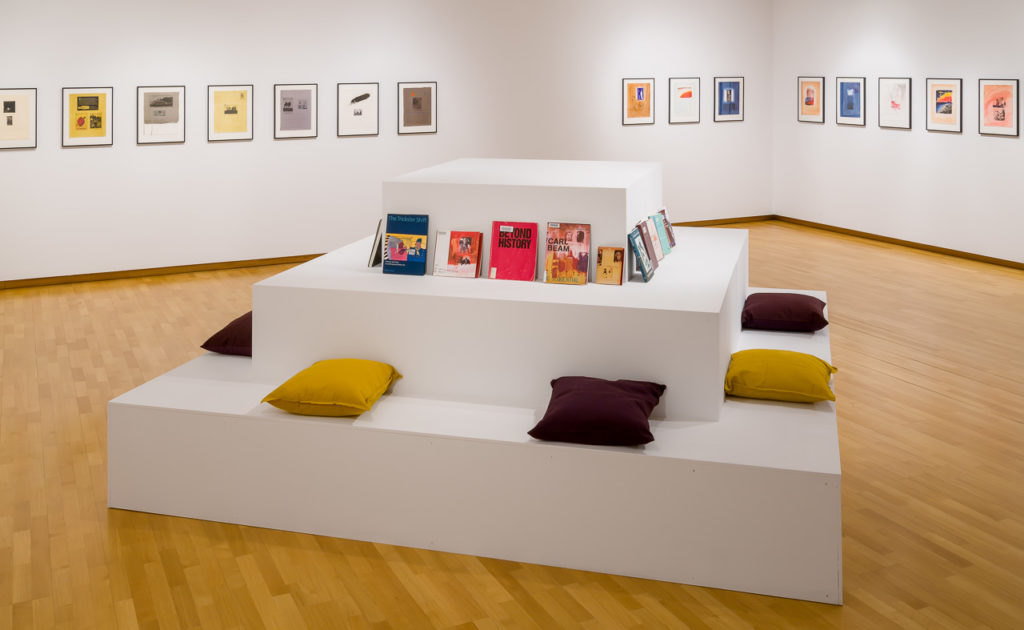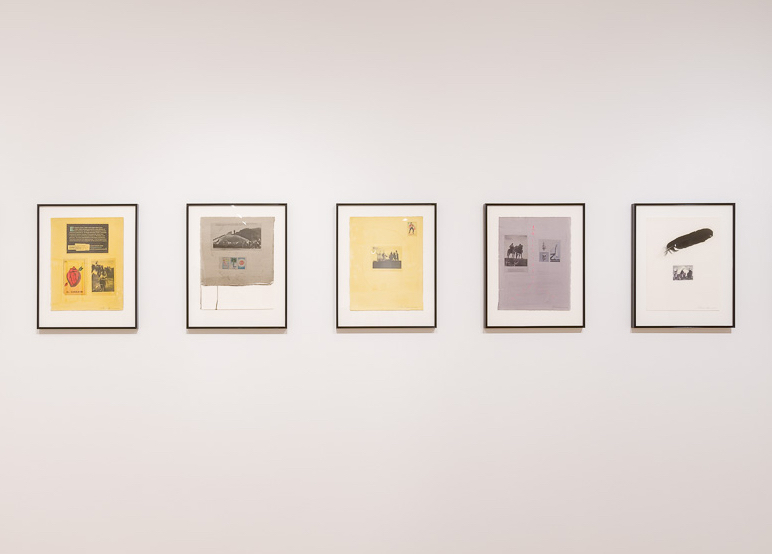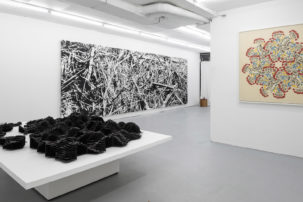Parsing the details of “Ann Beam and Carl Beam: Spaces for Reading” is like leafing through unbound pages of a book whose encyclopedic contents spill from the cosmic to the colonial, the nautical to the nuclear. The artists’ bonds—as partners in life and in each of their individual art practices—deliberately bridge the familial with the sociopolitical while breaking apart the established chronicles of Indigenous and non-Indigenous life. The exhibition gathers two series of works on paper from the gallery collection, where photo-transfer and drawing techniques alter the distribution, weight and alignment of cultural ideas. The accompanying reading room—presented as a ziggurat centrepiece—features a collection of both influential and rare texts selected by poet Mackenzie Ground and artist Sandra Semchuk in collaboration with writer Richard Hill, who have built upon the Beams’ expansive voices to fill the space with even more citations.
The exhibition explores the possibilities opened up through non-linearity, using an approach toward history and knowledge that is necessarily collaborative in nature. Carl Beam’s solvent-transfers appear on watercolour grounds filled with rich earthen fields of ochre, sienna, iron and umber. The washes form eddies on the page, a treatment that acidly dissolves the space and time between images. In one piece from the Untitled (17 Works) (1998) series, Chief Iron Shell sits above atomic nuclei. In another, a worn copy of Edward Curtis’s North American Indian is turned over to show a paperback barcode masked by the price sticker, appearing next to a lotería playing card. While similar in process and format, Ann Beam’s works are quite distinct, adorning and encircling activities such as hair brushing and house building in variants of rosy and mossy shades. Ann’s use of “studies of” and “narratives of” in the titles of her works suggests an ongoing process of transformation. The visual and textual juxtapositions are not intended here to be read in direct opposition, and collectively, these compositional plays warn against forcing simple equivalencies. The Beams’ transfer-based practices are more alchemical than that. The emulsified works are malleable, porous and considerate of deeply entangled notions of coexistence.
Knowledge is itself a time-based process, and learning is fundamentally an act of transfer from one entity to the next. Ideas and understandings are carried within—the body, the plant, the stone, the book—for a period of time, only to manifest differently somewhere else, at another time. The implications of Carl and Ann Beam’s artistic practices, considered individually and seen together, are significant in the work of decolonizing knowledge, and the unbounded open inquiry process of the exhibition serves those aims.

Installation view of "Ann Beam and Carl Beam: Spaces for Reading" at SFU Gallery, 2019. Photo: Blaine Campbell.

Installation view of "Ann Beam and Carl Beam: Spaces for Reading" at SFU Gallery, 2019. Photo: Blaine Campbell.

Installation view of "Ann Beam and Carl Beam: Spaces for Reading" at SFU Gallery, 2019. Photo: Blaine Campbell.

Installation view of "Ann Beam and Carl Beam: Spaces for Reading" at SFU Gallery, 2019. Photo: Blaine Campbell.

Installation view of "Ann Beam and Carl Beam: Spaces for Reading" at SFU Gallery, 2019. Photo: Blaine Campbell.

 Installation view of "Ann Beam and Carl Beam: Spaces for Reading" at SFU Gallery, 2019. Photo: Blaine Campbell.
Installation view of "Ann Beam and Carl Beam: Spaces for Reading" at SFU Gallery, 2019. Photo: Blaine Campbell.






